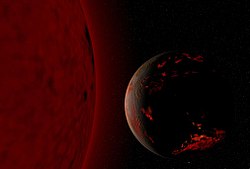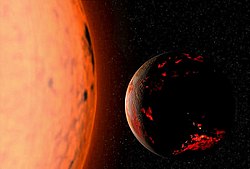Future of the Earth
The future of the Earth will depend on many things, including increases in the brightness of the Sun, loss of heat energy from the Earth's core and change of the planet's orbit by the other things in the Solar System. The Milankovitch theory says the planet will continue to go into glaciation cycles because of the planet's difference in orbit from a perfect circle, the axis of the planet tilting, and pushing of the Earth's orbit. As part of the supercontinent cycle, plate tectonics may create a supercontinent within 250 million–350 million years. Some time in the next 1.5 billion–4.5 billion years, the axis's tilt may begin to change into bad versions, with changes in the axis's tilt of up to 90°.
One billion to two billion years in the future, the increase in solar radiation caused by the helium build-up at the core of the Sun will result in the loss of the oceans and the cessation of continental drift. Four billion years from now, the increase in the Earth's surface temperature will cause a bad greenhouse effect. By that point, most if not all the life on the Earth will be gone. The most likely fate of the planet is being destroyed by the Sun in about 7.5 billion years, after the star has entered the red giant phase and expanded to cross the planet's orbit.
Human influence
Humans now play a top role in the biosphere, with the large amount of people in many of Earth's ecosystems.[2] This has caused a widespread, ongoing extinction of other species known as the Holocene extinction. The Holocene extinction event is the result of habitat destruction, the large distribution of invasive species, hunting and climate change.[3][4]
Solar evolution
- REDIRECT Template:See also
The energy generation of the Sun is based upon changing of hydrogen into helium. This occurs in the core region of the star.
When the Sun first became a main sequence star, it radiated only 70% of the current luminosity. The luminosity has increased in a nearly linear fashion to the present, increasing by 1% every 110 million years.[5] In three billion years the Sun is expected to be 33% more luminous. The hydrogen fuel at the core will finally be limited in 4.8 billion years, when the Sun will be 67% more luminous than at present. Thereafter the Sun will continue to burn hydrogen in a shell surrounding its core, until the increase in luminosity reaches 121% of the present value. This marks the end of the Sun's main sequence lifetime, and thereafter it will be into a red giant.[1]
Future Of The Earth Media
Horne foundry copper smelter in Rouyn-Noranda, Canada
Anti-nuclear weapons protest march in Oxford, 1980
The Barringer Meteorite Crater in Flagstaff, Arizona, showing evidence of the impact of celestial objects upon Earth
The rotational offset of the tidal bulge exerts a net torque on the Moon, boosting it while slowing the Earth's rotation (not to scale).
Pangaea was the last supercontinent to form before the present.
Evolution of the Sun's luminosity, radius and effective temperature compared to the present Sun. After Ribas (2010).
The atmosphere of Venus is in a "super-greenhouse" state. Earth in a few billion years could likely resemble present Venus.
Related pages
References
- ↑ 1.0 1.1 Sackmann, I.-Juliana; Boothroyd, Arnold I.; Kraemer, Kathleen E. (1993). "Our Sun. III. Present and Future". Astrophysical Journal. 418: 457–468. Bibcode:1993ApJ...418..457S. doi:10.1086/173407.
{{cite journal}}: CS1 maint: multiple names: authors list (link) - ↑ Vitousek, Peter M.; Mooney, Harold A.; Lubchenco, Jane; Melillo, Jerry M. (July 25, 1997). "Human Domination of Earth's Ecosystems". Science. 277 (5325): 494–499. doi:10.1126/science.277.5325.494.
{{cite journal}}: CS1 maint: multiple names: authors list (link) - ↑ Cowie, Jonathan (2007). Climate change: biological and human aspects. Cambridge University Press. p. 162. ISBN 978-0521696197.
- ↑ Thomas, C. D.; Cameron, A.; Green, R.E.; et al. (January 2004). "Extinction risk from climate change" (PDF). Nature. 427 (6970): 145–8. Bibcode:2004Natur.427..145T. doi:10.1038/nature02121. PMID 14712274. S2CID 969382.
{{cite journal}}: CS1 maint: multiple names: authors list (link) - ↑ Schröder, K.-P.; Connon Smith, Robert (2008). "Distant future of the Sun and Earth revisited". Monthly Notices of the Royal Astronomical Society. 386 (1): 155–163. arXiv:0801.4031. Bibcode:2008MNRAS.386..155S. doi:10.1111/j.1365-2966.2008.13022.x. S2CID 10073988.
{{cite journal}}: CS1 maint: multiple names: authors list (link)
Other websites
- Scotese, Christopher R. "PALEOMAP Project". Retrieved 2009-08-28.










